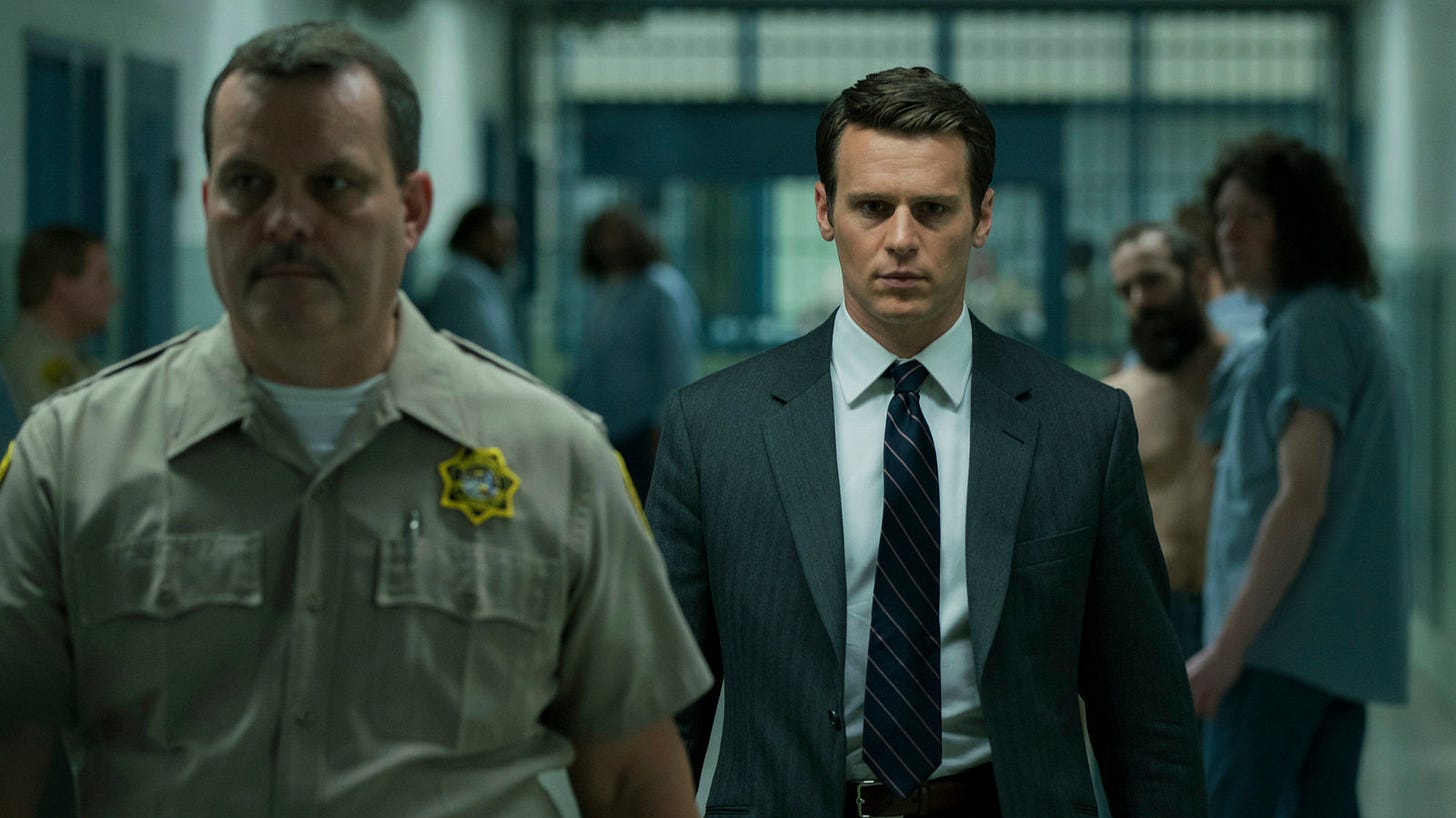How to Profile Your Protagonist Like the FBI? 6 Character-Building Lessons for Authors (Plus Personal Reflections)
So, if you’re an average author, writing thrillers at 2am and hoping no one at the FBI is watching your search history… what if authors could learn more from the FBI instead?
What if FBI methods of profiling could be more helpful than tracking criminals? Could we use it to craft compelling, believable characters?
This past month, I binged a Netflix series about the FBI, and how they invented character profiling. In reading it up afterward, I found 6 suggestions that could really help us authors build more interesting characters.
Let’s dive in. I want to know what you think.
It’s even possible that we can apply it to ourselves, to become better people.
1. Start With Behavior, Not Labels
Forget what you think you know about people. You don’t meet someone and say automatically, “He’s a narcissist.” (You might, but go with me.)
You might notice the way he lingers in mirrors. The way he interrupts without hearing. The way he drops praise like breadcrumbs, only to pull it away.
It’s the same with your characters.
Writers often try to sum people up with a single trait: loyal, rebellious, shy. But those are just signposts. What matters is what they do. What activities anchor them? What choices repeat like a drumbeat in their lives?
Don’t tell us who they are. Show us how they behave.
FBI Approach: Profiler training begins with observation, not interpretation. Actions before analysis. It’s not, “He’s antisocial,” but “He breaks into homes and rearranges furniture.”
Storyteller Take: Tolkien wouldn’t begin by calling Frodo “brave.” He’d show you the hobbit shouldering a burden meant for kings.
Writer Upgrade: Stop defining your characters with back-cover blurbs. Instead, pretend to watch them. What rituals do they follow? What details do they obsess over? Do they always sit facing the door? Avoid mirrors? Wear gloves even in summer?
Villain Example:
Sasha alphabetizes her books by color. Keeps her dead sister’s necklace in a Ziploc under her mattress. Hasn’t missed a sunrise walk in 13 years—and never brings her phone.
Hero Example:
Father Elias blesses his knife before every meal. He rewrites old homilies only in pencil, never pen. Every Sunday, he visits the grave of a man he couldn't save, even though it almost cost him his life.
Why it works:
Actions reveal values. Values reveal wounds. Wounds shape choices. If readers can see the behavior, they don’t need to be told the label. They’ll feel it.
2. Victimology: Who They Hurt or Help Reveals Their Heart
You want to know someone’s soul? Watch who they protect—and who they destroy.
In the field, investigators can start with the victims. They’re looking for the pattern. Who gets targeted. Why. That’s where the real story lives.
And it’s true in fiction too. Your character’s morality isn’t about what they claim to believe—it’s about who bleeds when they act. Who benefits, who’s spared, and why.
It’s not usually random. People carry ghosts. Memories. Regrets. We’re all reaching out or lashing out based on who we've lost, who we failed, or who we’re afraid to become.
That’s where your character’s compass is hidden.
FBI Approach: Victimology maps the emotional logic of the offender. Who they target tells you who they blame—or who they want to protect.
Storyteller Take: Characters often hurt those who mirror their own flaws. Martin Shaw would say: you’re always talking to your wild twin. It’s not always pleasant.
Writer Upgrade: Who does your protagonist choose to save, ignore, destroy, or forgive? Do they protect the weak—or the wicked? Do they destroy enemies—or old versions of themselves?
Villain Example:
A vigilante only protects red-haired women. His sister, abandoned in a burning building, had red hair. He doesn’t hunt criminals—he punishes those who looked away.
Hero Example:
A former assassin now guards abused children—not because he’s good, but because he once killed a child’s father by mistake. He builds shelters no one knows about. And he never talks about it.
Why it works: Who we protect reveals who we mourn. Who we harm can show what we fear. Your hero’s morality isn’t what they say—it’s how they act.
3. Organized vs. Disorganized: How They React to Stress
When the pressure hits, people don’t become someone else. They default to the programming or the habits they’ve practiced.
Some tighten. They get cold, precise. They try to control the chaos by sharpening every edge. Others erupt—into noise, confusion, panic. They become a storm.
This isn’t just a personality quirk. It’s a core training. If you want your character to feel real, you need to know what happens when the world starts burning. Do they freeze and calculate? Or do they lash out and unravel?
Their reaction to stress is a kind of truth serum. It bypasses their mask and reveals who they’ve practiced to be. It may not be who they really are. But in that moment, they’re going with that option.
FBI Approach: Under pressure, people don’t invent new behaviors—they fall into their default patterns. Organized characters become colder. Disorganized ones fall apart.
Storyteller Take: This is your character’s stress fingerprint. It’s not just a quirk—it’s a compass under fire, that they may want to change, but can’t yet.
Writer Upgrade: Ask: when the world cracks, do they become calculating—or chaotic? Do they suppress emotion—or spiral into it?
Villain Example:
Maya, a whistleblower, smiles as she fabricates alibis. She forges emails in advance, burns evidence with lavender oil, and sends her boss a birthday card minutes before leaking company files.
Hero Example:
Amara, a field medic in a war zone, hums lullabies while stitching wounds. When the shelling starts, she doesn’t run—she organizes triage by blood type. Her calm is terrifying. It’s the silence of someone who’s already made peace with death.
Why it works: Crisis doesn't change people—it reveals what’s under the surface. Let their stress signature be the way their default. And then reflect on it, to challenge themselves to do better.
4. Triggers: Nobody Snaps Without Warning
No one just explodes. Even the wildest breakdown has a pattern—a buildup, a pressure, a moment that breaks the dam. That’s the fuse. And it always starts earlier than we think.
In real investigations, there’s rarely one cause. It’s an accumulation of rejection, shame, failure, or more. Each one a small weight added to the heart—until it can’t hold any more.
Your job is to stack those moments. Not all at once, but like dominoes. So when your character finally breaks—when they act in a way that changes everything—it doesn’t feel random. It feels inevitable. Not because the plot demanded it, but because their soul did.
FBI Approach: Most offenders don’t just “go bad.” There’s a pattern of stressors—a series of betrayals, humiliations, or losses that culminate in a breaking point.
Storyteller Take: Jung might call this the eruption of the Shadow. It’s not random. It’s everything in themselves the character has been ignoring, shutting out, shutting down. At some point, the Shadow can’t take it any more. Then that’s a true test of self: are you overwhelmed and lash out on everything, or do you grieve, accept, and integrate the new information?
Writer Upgrade: Layer your character’s downfall (or breakthrough). Let each trigger add pressure. When they snap, it’s not a twist. It can make sense.
Villain Example:
Theo gets humiliated, then abandoned, then bereaved. When a stranger mocks him in Chapter 10, he unexpectedly breaks the man’s jaw with a crowbar. Readers gasp—but they understand.
Hero Example:
Captain Lira has buried guilt over letting her crew die. She’s throttling herself and self-sabotaging, believing she doesn’t deserve to lead, and hiding it from everyone. Until a rookie says, “Seems you lost someone who mattered to you.” Something reactivates. She realizes it wasn’t all on her, and she has a new team. She takes control of the failing mission, to redeem her past.
Why it works: Every hero breaks before they change. I like to think of stacking 3 failures before letting the character win. Stack the kindling. Then light the spark, and see what they do.
5. Cold vs. Hot Cognition: How They Justify What They Do
Everyone has a reason for what they do. The question is what kind of reason.
Some people run on heat—they’re driven by the burn of emotion. Hurt, anger, passion. They react fast, and justify later. Others run cold. Calculated. Strategic. They plan ten steps ahead and call it justice.
Neither one is better. But they’re different. And once you know how your character explains themselves, you can see the story behind the story.
What matters most is not the act—it’s the why they tell themselves. That internal reasoning? That’s the architecture of belief. That’s where morality, fear, and purpose all meet. And when you write from that place, your characters don’t just act—they confess.
FBI Approach: It’s not just what someone does—it’s how they explain it. Cold cognition is calculated. Hot is emotional. Both are rational—just to different parts of the soul.
Storyteller Take: Your culture can shape your reasoning. The way you explain away something say everything.
Writer Upgrade: After your character makes a hard choice, listen. What do they tell themselves about why? That inner monologue is gold.
Villain Example:
“She humiliated me. I had to make her pay.” (hot)
“She would have ruined the network. I protected it.” (cold)
Hero Example:
“If I waited for orders, he’d be dead. So I disobeyed.” (hot courage)
“I saw the probability matrix. There was only one viable path.” (cold sacrifice)
Why it works: Motivation shapes morality under stress. Your character’s justifications reveal whether they’re ruled by pain, duty, ego—or something deeper.
6. Place Is Personality
People leave fingerprints on places. But places also leave fingerprints on people.
Where do they go when they’re scared? Where do they feel powerful? What places do they avoid, not because of logic, but because of memory? Location isn’t just backdrop—it’s biography.
Especially in a story,—where everything is made up—everything you include reveals something. The backdrop compliments or contradicts the theme of the character, to show us more about them.
In fieldwork, location reveals comfort zones and hunting grounds. In stories, it reveals ghosts. Identity. Longing.
So don’t just set a scene. Ask: what does this place unlock in this character? Do they become more honest, or more hidden?
Place is not passive. It speaks through your character.
FBI Approach: Geographic profiling isn’t just about maps. It’s about where the subject feels seen or unseen. Home, power, shame—they’re tied to place.
Storyteller Take: Landscapes shape souls. Carl Jung explored the symbolic power of physical spaces, especially in dreams. He saw houses, rooms, or landscapes as reflections of the psyche. The rooms we dwell in, in dreams or in life, often correspond to dimensions of our inner world—conscious or unconscious.
Writer Upgrade: Map your character’s geography. Where do they return to? Where do they become someone else?
Villain Example:
Tyler sleeps only on the floor of his childhood home—even though he owns a luxury penthouse. That room is his anchor, his cage, and his sanctuary.
Hero Example:
Anya trains in an abandoned Russian chapel, where bullet holes from the gulag roundups still mark the walls. She can’t pray. The best she can do is kneel before a mission, and stuff a spent round in a bullet hole, like a shiny stud. This chapel is slowly becoming a sparkling marker of what must never, ever, happen again.
Why it works: Where your character feels is where they are. Let setting become story.
As authors, our craft becomes a mirror—when what we write starts to write us.
Each one of these FBI-inspired tools doesn’t just help us build characters; they can also help us uncover ourselves.
Think of them as inner profiling tools for your writer’s journey.
1. Start With Behavior, Not Labels
Reflection: What do you actually do—not what you say about yourself? Writers love words, but sometimes we use them to hide. I might call myself “disciplined,” but do my habits reflect that? I may see myself as “kind,” but how do you treat the people who can’t offer you anything?
Watch your patterns. Your rituals. Your defaults. Behavior is truth in motion. The more clearly you see your own, the more truthfully you’ll write others.
Ask Yourself: What is one unconscious behavior I repeat every day? What story might it be telling about me?
2. Victimology: Who You Protect or Avoid Tells a Story
Reflection: Who do you instinctively want to defend? Who makes you uncomfortable? Who do you judge too quickly?
This is one of the deepest tells for the writer. Our instincts to protect or avoid often trace back to our own wounds. When we create characters we want to save—or villains we despise—it can be a projection of something we need to work on.
But here’s the magic: if you follow those feelings, you might find the root of a fear, a shame, or even a buried piece of compassion.
Ask Yourself: Who do I want to rescue or destroy in my story—and why? What part of myself am I really talking to?
3. Organized vs. Disorganized Under Pressure
Reflection: How do you handle stress when no one’s watching? Do you get quiet, tighten control, and pretend nothing’s wrong? Or do you vent, spiral, and burn bridges?
Your stress pattern isn’t weakness. It’s a key. It shows you where the armor is strongest—and where the wounds still ache. Learning to see how you react under pressure helps you write more honestly. But more than that—it helps you live more intentionally.
Ask Yourself: What’s my stress signature? And how can I respond to pressure with more awareness, not just instinct?
4. Triggers: What Breaks You—And Why
Reflection: We all have fuses. They’re usually not lit by one match—but by a slow gathering of things we never voiced or faced.
As a writer, you can track your character’s breakdowns. But as a person, can you track your own? What triggers feel too familiar? What anger, sorrow, or despair has been quietly building?
If you follow that fuse, you might uncover the real reason a scene you wrote hit too hard. Or why a certain type of story keeps chasing you.
Ask Yourself: What trigger shows up in my life or writing again and again? What truth is it pointing toward?
5. Cold vs. Hot Justifications: How You Explain Yourself
Reflection: When you make a mistake—or a bold move—how do you explain it to yourself? Some of us default to logic, others to emotion. Some of us create stories that cast us as the noble victim. Others rewrite events to avoid blame. The mind is a master storyteller.
But just like with characters, the way we justify ourselves reveals our moral landscape. It shows what we fear most being seen as… and what we most need to believe.
Ask Yourself: What’s the last thing I justified—and how did I frame it? What does that say about the story I tell myself about who I am?
6. Place Is Personality
Reflection: Where do you go when you want to feel like yourself? And where do you feel like you’re pretending?
Place shapes us—sometimes more than we admit. There are rooms that make us bold, and others that make us small. Some of that is memory. Some of it is mystery. As a writer, your sacred spaces—your writing nooks, your childhood haunts, your daily routes—are maps to your soul. Those memories are the wardrobe your mind uses to clothe ideas, so that you can see and sense and smell them.
Ask Yourself: What’s one place that holds a version of me I’ve forgotten—or been afraid to visit? What would I discover if I went back?
Think deeper as an author
These reflections aren’t meant to fix anything. They’re meant to reveal you—like old fingerprints on a forgotten doorframe.
Writing unforgettable characters isn’t about inventing new quirks, but about making them feel real. They’re about recognition.
The more honestly we can see ourselves, the more deeply your characters will live. That’s why I believe an author is field-testing how to handle other people, because we are training ourselves to see people from the inside out. As persons, not objects.
The better author you are, the better human being you should also become. They’re linked.
FBI profilers track patterns to predict behavior. As writers, we do the same—but our goal isn’t just to understand our character. It’s to call to something real in the reader.
The truest stories don’t make a character do something because the plot demands it. They make the reader think:
“Of course they did that. There was no other choice.”
That’s truth with blood in its teeth.
Now the question is: if we don’t rise to the level of our expectations, we fall to the level of our training, and how have our characters trained?
As Vladimir Nabokov once said, “The writer's job is to get the main character up a tree, and then once they are up there, throw rocks at them.”
Related reading:
What do you think?
Comment below anything from this that was helpful to you!







This was an amazing post. I will definitely be looking at my characters in a different point of view now. Thank you so much for this insight on profiling.
A long article, but very thorough and helpful.